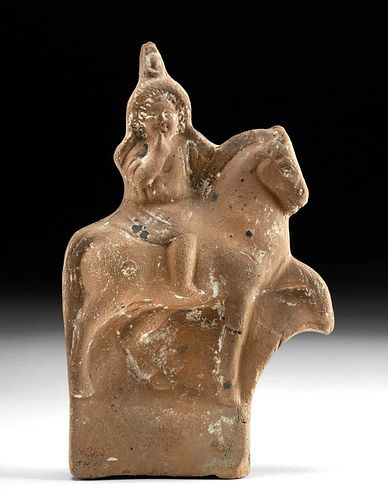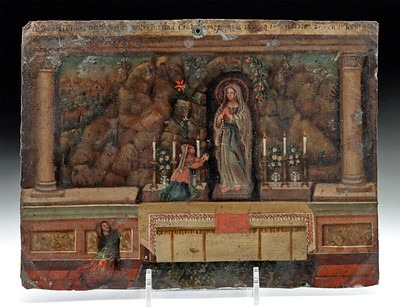Egyptian Alexandrian Statue Harpokrates Riding Horse
Lot 19
About Seller
Artemis Fine Arts
686 S Taylor Ave, Ste 106
Louisville, CO 80027
United States
Selling antiquities, ancient and ethnographic art online since 1993, Artemis Gallery specializes in Classical Antiquities (Egyptian, Greek, Roman, Near Eastern), Asian, Pre-Columbian, African / Tribal / Oceanographic art. Our extensive inventory includes pottery, stone, metal, wood, glass and textil...Read more
Estimate:
$1,000 - $1,500
Absentee vs Live bid
Two ways to bid:
- Leave a max absentee bid and the platform will bid on your behalf up to your maximum bid during the live auction.
- Bid live during the auction and your bids will be submitted real-time to the auctioneer.
Bid Increments
| Price | Bid Increment |
|---|---|
| $0 | $25 |
| $300 | $50 |
| $1,000 | $100 |
| $2,000 | $250 |
| $5,000 | $500 |
| $10,000 | $1,000 |
| $20,000 | $2,500 |
| $50,000 | $5,000 |
| $100,000 | $10,000 |
| $200,000 | $20,000 |
About Auction
By Artemis Fine Arts
Jun 15, 2023
Set Reminder
2023-06-15 10:00:00
2023-06-15 10:00:00
America/New_York
Bidsquare
Bidsquare : VARIETY Ancient, Ethno, Native American, Fine Art
https://www.bidsquare.com/auctions/artemis-gallery/variety-ancient-ethno-native-american-fine-art-12990
Antiquities, ethnographic, native american and fine art from cultures encompassing the globe. Artemis Fine Arts info@artemisfinearts.com
Antiquities, ethnographic, native american and fine art from cultures encompassing the globe. Artemis Fine Arts info@artemisfinearts.com
- Lot Description
Egypt, Alexandria, ca. 1st century BCE to 1st century CE. A mold-made earthenware statuette depicting Harpokrates (also Harpocrates), son of Osiris and Isis as well as the Egyptian god of silence, holding his right forefinger to his lips and riding a stallion. Harpokrates is dressed in a short tunic and wears a large wreath and a Double Crown. The hollow terracotta figure was made from a two-piece mold; the back is un-modeled and has a circular vent. Nice white pigment has survived in some areas. Size: 4.125" W x 6.625" H (10.5 cm x 16.8 cm)
Harpocrates (Harpokrates) was the god of silence - originally a Greek interpretation of the Egyptian deity Harpa-Khruti (Horus the Child) who was depicted as a boy with his finger held to his lips. This was an Egyptian symbol of childhood that the Greeks understandably mistook for the "hush" gesture of silence. References to Harpocrates appeared in classical literature, including Pseudo-Hyginus, Fabulae 277 (Roman mythographer c. 2nd century CE) and of course Ovid's Metamorphoses as we see in the following passage, "She saw before her bed, or seemed to see as in a dream, great (Egyptian goddess) Isis with her train of holy deities. Upon her brow there stood the crescent moon-horns, garlanded with glittering heads of golden grain, and grace of royal dignity: and at her side . . . (Harpocrates) the god who holds his finger to his lips for silence's sake." (Ovid, Metamorphoses 9.688 ff - trans. Melville - Roman epic ca. 1st century BCE to 1st century CE)
Interestingly, after Alexander the Great conquered Egypt, the Greeks appropriated the Egyptian god Horus to become their deity Harpocrates (literal meaning is "Horus the child"). Horus was regarded as the son of Isis and Osiris who avenged his father's death through several battles with Seth, the legendary god of Chaos. To the ancient Egyptians, Horus symbolized the sun as a newborn.
Provenance: ex-Royal Athena Galleries, New York City, New York, USA; ex-private French collection, acquired at Berge, Paris, November 2007, lot 493
All items legal to buy/sell under U.S. Statute covering cultural patrimony Code 2600, CHAPTER 14, and are guaranteed to be as described or your money back.
A Certificate of Authenticity will accompany all winning bids.
We ship worldwide and handle all shipping in-house for your convenience.
#123467Expected surface wear with pigment loss and minor nicks to peripheries. Nice mineral deposits and some white pigment remain.Condition
- Shipping Info
-
All shipping is handled in-house for your convenience. Your invoice from Artemis Gallery will include shipping calculation instructions. If in doubt, please inquire BEFORE bidding for estimated shipping costs for individual items.
-
- Buyer's Premium



 EUR
EUR CAD
CAD AUD
AUD GBP
GBP MXN
MXN HKD
HKD CNY
CNY MYR
MYR SEK
SEK SGD
SGD CHF
CHF THB
THB














